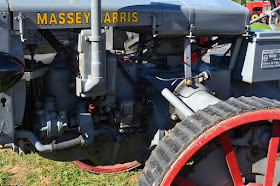Massey-Harris certainly wasn’t the first to build an all wheel drive tractor and they wouldn’t be the last. The concept may be sound but the devil lies in producing results that are measurably better and this was where the GP fell short. Try as they might, Massey’s engineers just couldn’t manage to pull more drawbar performance out of it than some of the competition managed with two wheels.
Introduced in 1930 the GP was rolled out just as the Great Depression was beginning to take its toll with production spanning the lean years until 1936. It was a time when farmers were in no mood to try something new, especially when popular competitors like the Fordson and the Farmall were available, usually at a lower price. Sales remained disappointing throughout the production run with only 3000 tractors sold at $1000 per copy.
It’s obvious that a lot of engineering went into this tractor. Every part on it serves a purpose, all muscle and bone with not a bit of fat anywhere. Beneath the gas tank that doubled as a hood lay the four cylinder 226 cubic inch Hercules power plant that connected through a three speed transmission to a transfer case and differential for each axle. A belt pulley and a rear PTO offered power transfer. Electric lights and starter along with an implement lift were offered as an option. A metal seat provided the only concession to operator creature comfort. It was a lean machine to be certain.
Massey sent the GP to Nebraska in 1930 where it was evaluated in test number 177 from May 5th to May 27. It managed a highest rating of 15 drawbar horsepower and 22 hp on the belt. Notes for the test indicate that no repairs or adjustments were required. Apparently Massey management was looking for a higher rating because they sent it back one year later when it underwent test number 191 from May 22nd to June 12, 1931. This proved to be a mistake because the best this tractor could manage was 13.02 hp drawbar and 20.31 on the belt. As if that wasn’t bad enough a number a parts failed and required repair or replacement during the course of the test. It clearly wasn’t what Massey had hoped for.
The GP measured 119 inches long, 55” high and cleared the ground by 30”. Front and rear tread options were: 40”, 60”, 66” and 76”. The tractor weighed in at 3900 pounds. Turning radius was six feet. Serial numbers began at 300001 in 1930 and ran to 303001 in 1936.
The 1932 model shown here is owned by Dave and Pat Kari who brought it from Minnesota to the 2017 Fall Harvest Days Antique Engine and Tractor Show near Asheville, NC. for the Massey Expo of North America 2017. Many thanks to them for contributing this interesting bit of history to the event.
Sources:
University of Nebraska Tractor Test Reports number 177 and 191.
www.mfpartsonline.com
The Big Book of Massey Tractors by Robert N. Pripps at books.google.com







No comments:
Post a Comment
Leave a comment or send an email to: stevedritch@gmail.com